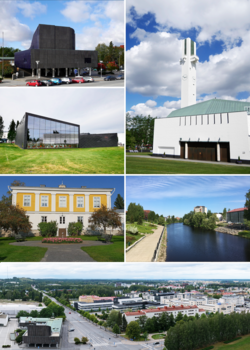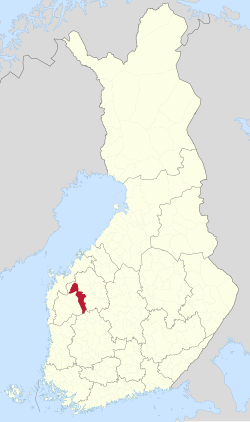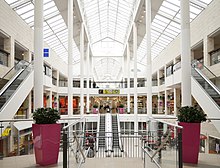Seinäjoki
You can help expand this article with text translated from the corresponding article in Finnish. (June 2023) Click [show] for important translation instructions.
|
Seinäjoki | |
|---|---|
City | |
| Seinäjoen kaupunki Seinäjoki stad | |
 | |
 Location of Seinäjoki in Finland | |
| Coordinates: 62°47.5′N 022°50.5′E / 62.7917°N 22.8417°E | |
| Country | |
| Region | South Ostrobothnia |
| Sub-region | Seinäjoki |
| Charter | 1868 |
| Market town | 1931 |
| Town | 1960 |
| Government | |
| • City manager | Jaakko Kiiskilä |
| Area (2018-01-01)[1] | |
• City | 1,469.23 km2 (567.27 sq mi) |
| • Land | 1,431.77 km2 (552.81 sq mi) |
| • Water | 37.59 km2 (14.51 sq mi) |
| • Urban | 52.78 km2 (20.38 sq mi) |
| • Rank | 48th largest in Finland |
| Population (2024-10-31)[2] | |
• City | 66,556 |
| • Rank | 16th largest in Finland |
| • Density | 46.49/km2 (120.4/sq mi) |
| • Urban | 46,639 |
| • Urban density | 883.6/km2 (2,289/sq mi) |
| Population by native language | |
| • Finnish | 95.3% (official) |
| • Swedish | 0.2% |
| • Others | 4.5% |
| Population by age | |
| • 0 to 14 | 17.1% |
| • 15 to 64 | 62.5% |
| • 65 or older | 20.4% |
| Time zone | UTC+02:00 (EET) |
| • Summer (DST) | UTC+03:00 (EEST) |
| Website | www |
Seinäjoki (Finnish: [ˈsei̯næˌjoki] ⓘ; lit. "Wall River"; Latin: Wegelia, formerly Swedish: Östermyra) is a city in Finland and the regional capital of South Ostrobothnia. Seinäjoki is located in the western interior of the country and along the River Seinäjoki. The population of Seinäjoki is approximately 67,000, while the sub-region has a population of approximately 132,000. It is the 16th most populous municipality in Finland, and the 13th most populous urban area in the country.
Seinäjoki is located 80 kilometres (50 mi) east of Vaasa, 178 kilometres (111 mi) north of Tampere, 193 kilometres (120 mi) west of Jyväskylä and 324 kilometres (201 mi) southwest of Oulu.
Seinäjoki originated around the Östermyra bruk iron and gunpowder factories founded in 1798. Seinäjoki became a municipality in 1868, a market town in 1931, and a town in 1960. In 2005, the municipality of Peräseinäjoki was merged into Seinäjoki, and at the start of 2009, the neighbouring municipalities of Nurmo and Ylistaro were amalgamated with Seinäjoki. The city itself is growing steadily from year to year, but the population of the surrounding municipalities is correspondingly decreasing.[6]
The city hall, city library, Lakeuden Risti Church and other public buildings were designed by Alvar Aalto. Seinäjoki was historically called Östermyra in Swedish. Today, this name, which was never official, is very seldom used even among Swedish speakers. Seinäjoki Airport is located in the neighbouring municipality of Ilmajoki, 11 kilometres (10 mi) south from the Seinäjoki city centre. Seinäjoki railway station in city centre was opened in 1883 and until 1897, it carried the name Ostermyra station.
History
[edit]The settlement spread in the area of the present Seinäjoki during the first half of the 16th century. During the 1550s, there is said to have been three houses in Seinäjoki: the houses of Marttila, Jouppi and Uppa. The house of Jouppila, which separated from the house of Jouppi, was established during the same century. All of the houses were located on the shore of the river.
Seinäjoki belonged to the church parish of Ilmajoki like Kurikka, Kauhajoki, Jalasjärvi and Alavus. However, in the 18th century the roads from Seinäjoki to the Church of Ilmajoki were generally in poor condition. Therefore, the inhabitants of Seinäjoki and the neighbouring Nurmo built a new chapel together in 1725, which in 1765 led to the formation of the chapel town of Nurmo. Seinäjoki, which was called Alaseinäjoki since the Greater Wrath, became a part of the chapel town. The chapel parish of Peräseinäjoki was founded in 1798, and the village of Alaseinäjoki began to be called Seinäjoki again. The very same year, the Östermyra steel mill was founded on the shore of the Seinäjoki river.

In the 1850s, actions were taken to separate Seinäjoki from the church parish of Nurmo. Ilmajoki wanted to connect Seinäjoki back to its own parish. In spite of strong objections from the inhabitants of Nurmo, the Senate of Finland accepted the petition from the inhabitants of Seinäjoki in 1863, to form a chapel congregation of their own. Seinäjoki got an independent local government in 1868. In 1900, Seinäjoki became an independent municipality.
Seinäjoki has grown around a few important railroad crossings. The Tampere–Vaasa railway, which passes through Seinäjoki, was inaugurated in 1883. The track, along with the Kokkola track that was opened for rail service in 1885, and the Kristinestad track which had been completed in 1913, raised Seinäjoki as an important railway crossing section in Finland. In the early 1970s, a direct railway between Tampere and Seinäjoki was opened, and the services of Seinäjoki improved further.
After the Winter War and Continuation War, some refugees from Jaakkima and Lumivaara were resettled to Seinäjoki.
Geography
[edit]
The neighboring municipalities of Seinäjoki are Kauhava in the north, Lapua in the northeast, Kuortane and Alavus in the east, Virrat and Kihniö in the south, Ilmajoki and Kurikka in the west and Isokyrö in the northwest.
The proportion of water in the Seinäjoki landscape is small. Seinäjoki River flows through the city in a south-east-northwest direction and turns at the northern border of the city center, connecting with the Kyrönjoki River,[7] which flows into the Gulf of Bothnia in the Vaasa area.
The most significant road connections in Seinäjoki are highways 16, 18 (between cities of Vaasa and Jyväskylä), 19 and 67.
Climate
[edit]| Climate data for Seinäjoki Pelmaa (1991-2020 normals, extremes 1959–present) | |||||||||||||
|---|---|---|---|---|---|---|---|---|---|---|---|---|---|
| Month | Jan | Feb | Mar | Apr | May | Jun | Jul | Aug | Sep | Oct | Nov | Dec | Year |
| Record high °C (°F) | 8.6 (47.5) |
9.8 (49.6) |
15.4 (59.7) |
24.5 (76.1) |
29.2 (84.6) |
32.6 (90.7) |
33.6 (92.5) |
31.5 (88.7) |
27.7 (81.9) |
20.6 (69.1) |
12.9 (55.2) |
9.1 (48.4) |
33.6 (92.5) |
| Mean daily maximum °C (°F) | −2.6 (27.3) |
−2.7 (27.1) |
1.7 (35.1) |
8.2 (46.8) |
15.0 (59.0) |
19.5 (67.1) |
22.1 (71.8) |
20.5 (68.9) |
15.0 (59.0) |
7.4 (45.3) |
2.1 (35.8) |
−0.8 (30.6) |
8.8 (47.8) |
| Daily mean °C (°F) | −5.6 (21.9) |
−6.2 (20.8) |
−3.5 (25.7) |
3.3 (37.9) |
9.2 (48.6) |
14.1 (57.4) |
16.7 (62.1) |
14.9 (58.8) |
10.0 (50.0) |
4.3 (39.7) |
−0.1 (31.8) |
−4.3 (24.3) |
4.6 (40.3) |
| Mean daily minimum °C (°F) | −9.2 (15.4) |
−10.1 (13.8) |
−6.8 (19.8) |
−1.1 (30.0) |
3.1 (37.6) |
8.1 (46.6) |
11.0 (51.8) |
9.6 (49.3) |
5.5 (41.9) |
1.3 (34.3) |
−2.5 (27.5) |
−6.4 (20.5) |
0.2 (32.4) |
| Record low °C (°F) | −40.5 (−40.9) |
−43.6 (−46.5) |
−31.4 (−24.5) |
−21.1 (−6.0) |
−7.6 (18.3) |
−3.0 (26.6) |
−0.8 (30.6) |
−2.4 (27.7) |
−7.4 (18.7) |
−22.8 (−9.0) |
−29.4 (−20.9) |
−37.3 (−35.1) |
−43.6 (−46.5) |
| Average precipitation mm (inches) | 32 (1.3) |
24 (0.9) |
26 (1.0) |
28 (1.1) |
46 (1.8) |
59 (2.3) |
74 (2.9) |
73 (2.9) |
54 (2.1) |
58 (2.3) |
47 (1.9) |
40 (1.6) |
561 (22.1) |
| Average relative humidity (%) | 90 | 87 | 80 | 74 | 68 | 70 | 77 | 80 | 85 | 90 | 93 | 92 | 82 |
| Mean monthly sunshine hours | 30 | 71 | 145 | 189 | 267 | 276 | 268 | 207 | 140 | 80 | 31 | 17 | 1,718 |
| Source 1: FMI normals for Finland 1991-2020[8] | |||||||||||||
| Source 2: Record highs and lows [9] | |||||||||||||
Demographics
[edit]Population
[edit]| Year | Pop. | ±% p.a. |
|---|---|---|
| 1940 | 5,085 | — |
| 1972 | 38,296 | +6.51% |
| 1980 | 42,497 | +1.31% |
| 1990 | 47,182 | +1.05% |
| 2000 | 50,670 | +0.72% |
| 2010 | 57,811 | +1.33% |
| 2020 | 64,130 | +1.04% |
| Source: Tilastollinen päätoimisto,[10] Statistics Finland (1972-2020)[11] | ||
The city of Seinäjoki has 66,556 inhabitants, making it the 16th most populous municipality in Finland. The Seinäjoki region has a population of 131,887. In Seinäjoki, 4.6% of the population has a foreign background, which is below the national average.[12]
| Year | Population |
|---|---|
| 1990 | |
| 1995 | |
| 2000 | |
| 2005 | |
| 2010 | |
| 2015 | |
| 2020 |
Languages
[edit]Population by mother tongue (2023)[12]
Seinäjoki is a monolingual Finnish-speaking municipality. The majority of the population - 63,023 people or 95.3% - speak Finnish as their first language. In Seinäjoki, 152 people, or 0.2% of the population, speak Swedish.[12] 4.5% of the population of Seinäjoki have a mother tongue other than Finnish or Swedish.[12] As English and Swedish are compulsory school subjects, functional bilingualism or trilingualism acquired through language studies is not uncommon.
At least 30 different languages are spoken in Seinäjoki. The most common foreign languages are Ukrainian (0.6%), Russian (0.5%), English (0.3%), Arabic (0.3%) and Estonian (0.3%).[12]
Immigration
[edit]| Population by country of birth (2022)[11] | ||
| Nationality | Population | % |
|---|---|---|
| 62,819 | 96.2 | |
| 308 | 0.5 | |
| 164 | 0.3 | |
| 159 | 0.2 | |
| 142 | 0.2 | |
| 113 | 0.2 | |
| 111 | 0.2 | |
| 94 | 0.1 | |
| 87 | 0.1 | |
| 70 | 0.1 | |
| 64 | 0.1 | |
| Other | 1,192 | 1.8 |
As of 2023[update], there were 3,036 persons with a migrant background living in Seinäjoki, or 4.6% of the population.[note 1] The number of residents who were born abroad was 3,180, or 4.8% of the population. The number of persons with foreign citizenship living in Seinäjoki was 2,211.[12] Most foreign-born citizens came from the Sweden, Thailand, Estonia and former Soviet Union.[11]
The relative share of immigrants in Seinäjoki's population is below to the national average. However, the city's new residents are increasingly of foreign origin. This will increase the proportion of foreign residents in the coming years.
Religion
[edit]In 2023, the Evangelical Lutheran Church was the largest religious group with 76.7% of the population of Seinäjoki. Other religious groups accounted for 2.1% of the population. 21.2% of the population had no religious affiliation.[14]
Economy
[edit]
Nordic Regional Airlines has its financial office in Seinäjoki.[15] Its predecessor, Finncomm Airlines, had its head office on the grounds of Seinäjoki Airport in nearby Ilmajoki.[16]
In terms of market area, Seinäjoki is the sixth largest city in the country.[17] Also Seinäjoki has a nationally and internationally significant food production and R&D industry. Headquartered in Seinäjoki food company Atria Corporation's net sales in 2009 were EUR 1316 million and it employed an average of 6,214 persons in several countries. According to a study published by the Economic Survey at the end of 2018, Seinäjoki has the best image among corporate leaders among the 36 largest Finnish cities and municipalities. The survey had asked the CEOs and CFOs of companies operating in the area about the municipality's affairs.[18]
Seinäjoki also is well known for having a large number of SME's and a big number of shops for its size. One of the most important shopping places in Seinäjoki is the Torikeskus shopping mall in the city center.
Culture
[edit]There are many kinds of cultural events in Seinäjoki nowadays. For example, Seinäjoki is known for hosting three large summer events: Tangomarkkinat, which is a tango festival typically attracting more than 100,000 visitors annually, Vauhtiajot, which is a motor racing event/music festival, and Provinssirock, which is one of the largest and oldest rock festivals in Finland. Rytmikorjaamo is a popular rock club, wherein almost every weekend some Finnish or international artists perform. In Seinäjoki there are also several other bars and clubs offering live music and other entertainment. The city theatre of Seinäjoki has a wide, quality program throughout the year, offering plays for everyone. The city orchestra of Seinäjoki performs many concerts in the area and has had many tours in Finland and abroad.
Sport
[edit]
Seinäjoki is home to a big number of sports clubs, such as SJK Seinäjoki, a professional football team that competes in the Finnish Veikkausliiga. SJK is one of the top football teams in Finland and it plays in the brand new OmaSp Stadion. Seinäjoki is also home to Seinäjoki Crocodiles, an American football team.
Seinäjoki Speedway track is a motorcycle speedway venue located on the south east outskirts of the city, off the Routakalliontie road by the quarry.[19] The track held a qualifying round of the Speedway World Team Cup in 1992[20] and has held the final of the Finnish Individual Speedway Championship on 11 occasions from 1986 to 2020.[21]
Seinäjoen JymyJussit and Seinäjoen Maila-Jussit are the city's men's and women's pesäpallo teams respectively in the Superpesis national league, playing at Seinäjoki Pesäpallo Stadium.
Sights
[edit]- Lakeuden Risti Church ("The Cross of the Plains")
- Alvar Aalto's cultural and administrative centre, comprising the City Hall, library and theatre, among others
- The Mannerheim Park
- The Southern Ostrobothnia District Museum
- The Civil Guard and Lotta Svärd Museum, located at the Seinäjoki Civil Guard House
- Törnävä church
- The railway exhibition
- Mallaskoski brewery
Other points of interest
[edit]- Törnävä Museum Area
- the Suviyö trotting-race
- Törnävä summer theatre – Seinäjoki
- Jouppi mountain winter sports centre
- Seinäjoki City Theatre
- Provinssirock
- Tangomarkkinat
- Vauhtiajot
Education
[edit]Seinäjoki University of Applied Sciences (SeAMK) is the local higher education institution, that also pursues an international profile.
Notable people
[edit]- Jukka Hildén, stuntman, The Dudesons
- Antti Isotalo, jäger, tribal warrior, Alko's local leader
- Katja Kankaanpää, mixed martial artist
- Mari Kiviniemi, politician (Prime Minister of Finland 2010—2011)
- Paula Koivuniemi, singer
- Petri Kontiola, hockey player
- Pekka Koskela, speed skater
- Jarno Laasala, stuntman, The Dudesons
- Hannu Lahtinen, world wrestling champion
- Veli Lampi, soccer player
- Jarppi Leppälä, stuntman, The Dudesons
- Tapio Luoma, Archbishop
- Jorma Ollila, former Chairman and CEO of the Nokia Corporation
- Hannu-Pekka "HP" Parviainen, snowboarder, stuntman, The Dudesons
- Pekka Puska, public health researcher and official
- Paula Risikko, Member of Parliament and Minister
- Arto Saari, skateboarder
- Softengine, rock pop band
International relations
[edit]Twin towns — Sister cities
[edit]Seinäjoki is twinned with:[22]
See also
[edit]Sources
[edit]Literatures
[edit]- Reino Ala-Kulju (1963). Seinäjoen kirja (in Finnish). Seinäjoen seurakunta.
- Aulis J. Alanen (1970). Seinäjoen historia I (in Finnish). Seinäjoen kaupunki.
- Annikki Kyttä & Tenho Takalo (1977). Seinäjoen historia II (in Finnish). Seinäjoen kaupunki. ISBN 951-99131-5-7.
References
[edit]- ^ "Area of Finnish Municipalities 1.1.2018" (PDF). National Land Survey of Finland. Retrieved 30 January 2018.
- ^ "Finland's preliminary population figure was 5,635,560 at the end of October 2024". Population structure. Statistics Finland. 2024-11-19. ISSN 1797-5395. Retrieved 2024-11-22.
- ^ "Population growth biggest in nearly 70 years". Population structure. Statistics Finland. 2024-04-26. ISSN 1797-5395. Retrieved 2024-04-29.
- ^ "Population according to age (1-year) and sex by area and the regional division of each statistical reference year, 2003–2020". StatFin. Statistics Finland. Retrieved 2 May 2021.
- ^ a b "Luettelo kuntien ja seurakuntien tuloveroprosenteista vuonna 2023". Tax Administration of Finland. 14 November 2022. Retrieved 7 May 2023.
- ^ Niemistö, Elina (22 September 2022). "Seinäjoen väkiluku ylitti uuden tuhatluvun – muuten maakunnasta ei ole hyvää kerrottavaa" (in Finnish). YLE. Retrieved 15 March 2024.
- ^ Reino Ala-Kulju (1963). Seinäjoen kirja (in Finnish). Seinäjoen seurakunta.
- ^ "FMI normals 1991-2020" (PDF). fmi.fi. Retrieved 22 February 2024.
- ^ "FMI open data". FMI. Retrieved 22 February 2024.
- ^ "Suomen tilastollinen vuosikirja 1940" (PDF) (in Finnish). Tilastollinen päätoimisto. 1941. Retrieved 5 January 2025.
- ^ a b c d "Number of foreign-language speakers grew by nearly 38,000 persons". Statistics Finland. 31 May 2023. Retrieved 12 September 2023.
- ^ a b c d e f "Population growth biggest in nearly 70 years". Population structure. Statistics Finland. 2024-04-26. ISSN 1797-5395. Retrieved 2024-04-29.
- ^ "Persons with foreign background". Statistics Finland. Retrieved 18 September 2023.
- ^ Key figures on population by region, 1990-2023 Statistics Finland
- ^ "About Us." Nordic Regional Airlines. Retrieved on October 25, 2016.
- ^ "Contact Information." Finncomm Airlines. Retrieved on 25 February 2010.
- ^ "Kauppa-Joupin asemakaavoitus, Kaupallisten ja sosiaalisten vaikutusten arviointi" (PDF). Entrecon (in Finnish). Seinäjoen kaupunki. May 10, 2010. Retrieved November 16, 2020.
- ^ "Seinäjoella on paras imago" (in Finnish). Taloustutkimus (taloustutkimus.fi). December 11, 2018. Retrieved November 16, 2020.
- ^ "Seinäjoen Moottorikerho". Seinäjoen Moottorikerho. Retrieved 13 February 2024.
- ^ "Speedway World Cup". International Speedway. Retrieved 13 February 2024.
- ^ "Speedway Individual Finnish Championship". Speedway Sanomat. Retrieved 13 February 2024.
- ^ "Twinning and partnership cities". City of Seinäjoki. Retrieved 27 September 2024.
Notes
[edit]External links
[edit]![]() Media related to Seinäjoki at Wikimedia Commons
Media related to Seinäjoki at Wikimedia Commons
 Seinäjoki travel guide from Wikivoyage
Seinäjoki travel guide from Wikivoyage- Seinäjoki – Official website
- Provinssi – rock festival
- Tangomarkkinat – tango festival




